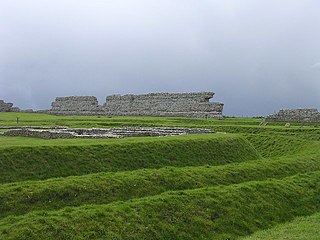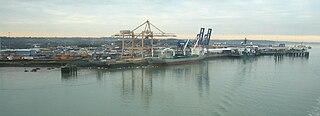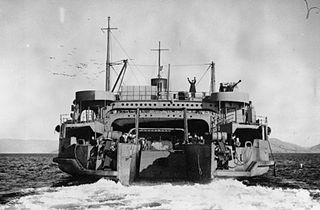
Harwich is a town in Essex, England, and one of the Haven ports on the North Sea coast. It is in the Tendring district. Nearby places include Felixstowe to the north-east, Ipswich to the north-west, Colchester to the south-west and Clacton-on-Sea to the south. It is the northernmost coastal town in Essex.

The London and North Eastern Railway (LNER) was the second largest of the "Big Four" railway companies created by the Railways Act 1921 in Britain. It operated from 1 January 1923 until nationalisation on 1 January 1948. At that time, it was divided into the new British Railways' Eastern Region, North Eastern Region, and partially the Scottish Region.

The Southern Railway (SR), sometimes shortened to 'Southern', was a British railway company established in the 1923 Grouping. It linked London with the Channel ports, South West England, South coast resorts and Kent. The railway was formed by the amalgamation of several smaller railway companies, the largest of which were the London and South Western Railway (LSWR), the London, Brighton and South Coast Railway (LB&SCR) and the South Eastern and Chatham Railway (SE&CR). The construction of what was to become the Southern Railway began in 1838 with the opening of the London and Southampton Railway, which was renamed the London & South Western Railway.
Roll-on/roll-off ships are cargo ships designed to carry wheeled cargo, such as cars, motorcycles, trucks, semi-trailer trucks, buses, trailers, and railroad cars, that are driven on and off the ship on their own wheels or using a platform vehicle, such as a self-propelled modular transporter. This is in contrast to lift-on/lift-off (LoLo) vessels, which use a crane to load and unload cargo.

Richborough is a settlement north of Sandwich on the east coast of the county of Kent, England. Richborough lies close to the Isle of Thanet. The population of the settlement is included in the civil parish of Ash.

Harwich International railway station on the Mayflower Line, a branch of the Great Eastern Main Line, serves Harwich International Port in Essex, England. It is 68 miles 72 chains (110.88 km) from London Liverpool Street, between Wrabness to the west and Dovercourt to the east. Its three-letter station code, HPQ, derives from its original name, Harwich Parkeston Quay.
The Eastern Region was a region of British Railways from 1948, whose operating area could be identified from the dark blue signs and colour schemes that adorned its station and other railway buildings. Together with the North Eastern Region, it covered most lines of the former London and North Eastern Railway, except in Scotland. By 1988 the Eastern Region had been divided again into the Eastern Region and the new Anglia Region, with the boundary points being between Peterborough and Whittlesea, and between Royston and Meldreth. The region ceased to be an operating unit in its own right in the 1980s and was wound up at the end of 1992.

Harwich Town railway station is the eastern terminus of the Mayflower Line, a branch of the Great Eastern Main Line, in the East of England, serving the port town of Harwich, Essex. It is 70 miles 61 chains (113.88 km) from London Liverpool Street; the preceding station on the line is Dovercourt. Its three-letter station code is HWC.

USS Prairie (AD-5), formerly Morgan Liner SS El Sol, was built in 1890 by William Cramp & Sons, Philadelphia. She was purchased by the United States Navy on 6 April 1898 from the Southern Pacific Company, and commissioned two days later at New York, Commander Charles J. Train in command.

Harwich International Port is a North Sea seaport in Essex, England, and one of the Haven ports. It lies on the south bank of the River Stour one mile upstream from the town of Harwich, opposite the Port of Felixstowe. The port was formerly known as Parkeston Quay.

USS Redwing (AM-48) was an Lapwing-class minesweeper commissioned by the United States Navy for service in World War I. She was responsible for removing mines from harbors, and, in her role as rescue and salvage ship, she was responsible for coming to the aid of stricken vessels. She was laid down 5 August 1918 by the Baltimore Drydock & Shipbuilding Co., Baltimore, Maryland; launched 7 June 1919; sponsored by Mrs. Fred A. Plagemann, wife of the prospective commanding officer; and commissioned 17 October 1919.

The Hook Continental was a passenger train running between London's Liverpool Street Station and Harwich Parkeston Quay where it connected with the night ferry sailing to the Hook of Holland in the Netherlands. It was introduced as a named express by the London and North Eastern Railway (LNER) in 1927, and was part of the marketing strategy pushing the concept of almost seamless travel from London overnight to numerous European destinations utilising the company's own ships and the rail connections from the Hook of Holland.

Brussels was a passenger ferry built in 1902 for the British Great Eastern Railway. In 1915, she tried to ram U-33. The ship was captured by Germany in 1916 and her captain, Charles Fryatt was executed after the Germans discovered his attempted ramming. Brussels was renamed Brugge and used as a depôt ship at Zeebrugge.
Associated Humber Lines (AHL) was created in 1935 to manage the services of various railway controlled shipping lines including port activities in the Humber area of the United Kingdom. The ownership of the respective vessels did not transfer to A.H.L and similarly the ports concerned, Hull, Goole and Grimsby, also remained under the control of the railway companies and their successors.
Suffolk Ferry was a train ferry built for the London and North Eastern Railway in 1947. She was subsequently operated by British Railways and Sealink before being withdrawn in 1980 and scrapped in Belgium in 1981.

TSS Train Ferry No. 1 was a roll on roll off freight vessel built for the British War Office in 1917 to transport rail freight to Europe during the First World War. After the war, it was used for civilian purposes until the Second World War. During the war it was converted to carry and launch landing craft

TSS Train Ferry No. 3 was a roll on/roll off freight vessel built for the British War Office in 1917.
TSS Vienna was a passenger and freight vessel built for the London and North Eastern Railway in 1929.

TSS Prague was a passenger and freight vessel built for the London and North Eastern Railway in 1929. The first group of Kindertransport refugees to arrive in the UK did so aboard the Prague, in December 1938.

The Dover–Dunkerque train ferry was one of two regular rail freight train ferries that operated between the United Kingdom and Europe. The route connected the English port of Dover, with the French port of Dunkerque. After rationalisation of other Anglo-European train ferries, the Dover to Dunkerque sailing was the last to survive, though it ended its days on freight carryings only after the Night Ferry passenger service ended in 1980. The last Dover to Dunkerque wagon-freight ferry service became redundant upon the opening of the Channel Tunnel when freight was carried directly through the Channel Tunnel.














